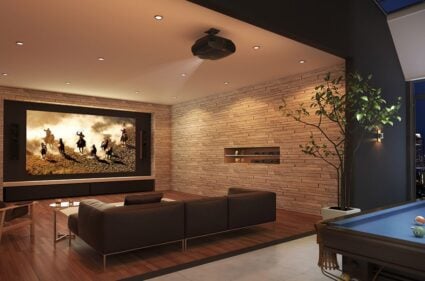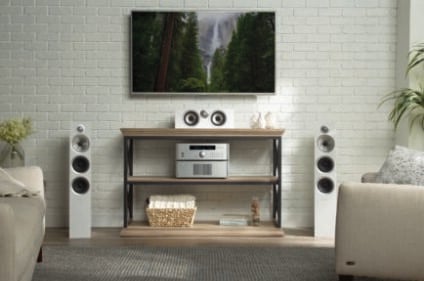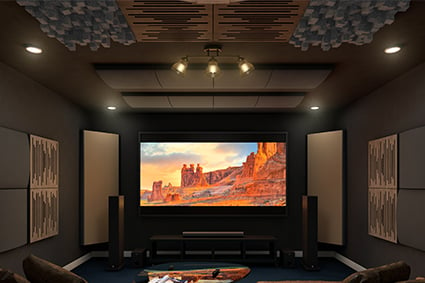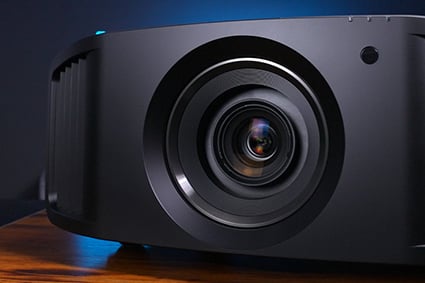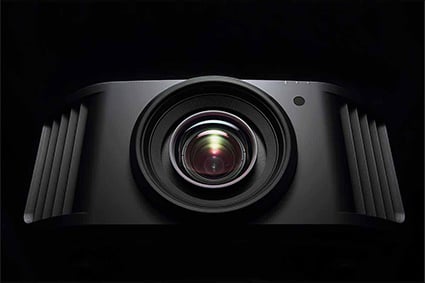Now we have to do a little math.
The idea golden range for the 140” 2.35 image will be 185 *1.1 which equals 203.5” and the maximum ideal range is 376.4-((376.4-185)/2) which equals 280.7”, this gives us a pretty wide range.
Then we will just round to the closest size of our 112” diagonal and look at the numbers for a 110” 16:9. The minimum is 137.4*1.1 which equals 151.14” and the maximum is 279.5-((279.5-137.4)/2) which equals 208.5”. Now since 112” is technically 1.82% larger than 110, take your 208.8 and multiply it by 1.0182 which will give you 212.3”
You then have to look at both sets of numbers and can see in this example the perfect range for both image sizes is very tight and falls between 203.5” and 212.3”.
If you can get your projector in this small range, you will be in that golden throw distance which JVC tells us gives the very best image. If you can not, in this example you would want to do the math for 10% on each end and look at both sets of numbers and stay within those suggested ranges.
While this may seem like a lot of calculating, remember, your projector is probably going to be hanging in that spot for a long time. Getting it right will make your image look better than if you did not pay attention to these numbers.
When you are making your final measurements, remember the throw distance is the distance from the screen material to the front of the projector lens.
You will also want to get the height of your projector in relation to the screen at the ideal position. In the perfect world, it would be dead centered on the screen, but that is usually not possible in a typical home theater. While the NX series does have lens shift, we highly recommend you get your projector perfectly centered left to right and keep the top of the lens height right at or below the height your screen material is off the floor.
If you must raise it up more, please use the chart on page 18 to calculate the amount you can, but it is best to stay within the screen if at all possible.
Also, be sure both your screen and projector are perfectly level.
Fine Tuning
Once you have your projector hung in the right spot, it’s time to get your image perfectly zoomed in and focused. If you pull up the installation menu and go to Image Pattern, turn it on and use the lens control functions on the remote to zoom, shift, and focus. If you have a widescreen, you will need to do this for both 16:9 and your widescreen image and store each setting. You can do this under the Installation Menu where you actually have up to 10 settings you can store and name. These can not only store your lens memory settings but any picture settings as well, which is pretty cool.
Pixel Alignment
During shipping, it is highly likely the 3 panels in your NX projector will have gotten slightly out of alignment. This is the part that will make the biggest difference of anything you can do! It is a bit time-consuming, but in our opinion is well worth it.
You will want your projector to have been warming up for at least 30 minutes before you start this. There is no need for your projector to have burned in at all though, you can do this right out of the box.
You can read about the steps starting on page 55 in the manual. We suggest you do the whole, then the fine-tune steps.
It is a tedious process and the best tip we can give you is to give your eyes a break as you are going to be staring at some bright white lines. We find if you’ll close your eyes for about 10-20 seconds before you go to the next zone, you’ll be able to focus better on the adjustments.
Settings Adjustments
As we said earlier, you do not want to change the projector’s default settings. JVC tells us they have spent a lot of time getting them right and you’ll get the best picture if you just leave them alone.
HDR
There are some things though you will want to do. JVC’s new HDR software will give you great results, but you will need to tell the software some details about your system.
Here is the link to the new instructions. We suggest you choose the “mid” optimize level.
Gaming
If you want to enjoy video gaming on your NX projector, we recommend you use one of the 9 presets to store a setting for gaming only as for normal content the picture is better with the gaming mode off. However, this setting does reduce lag. This is found under the Picture menu, Motion Control, then Low Latency- turn this on but leave the other two motion settings off.
Fast Moving Sports
Some people like to try the motion reduction software which is also found under Motion Control, you can experiment with the settings under Motion Enhance and if you prefer them, store them under another preset
Content That Seems Too Dark
If you are watching content that seems too dark, you can try going into the Picture Adjust/Aperture and try Auto 2. This will probably make the image a little brighter.
JVC’s Special Auto-Calibration Software
If you do want to take things a little further down the calibration route, you can download JVC’s free software here.
This software requires a Windows laptop and an aftermarket Datacolor Spyder5 which will run you about $200. You will also need a good tripod to attach the Spyder to that allows you to put it in the exact middle of your screen.
If you can do all this, it is automatic and you will just follow the steps. Be sure to remember to export the new settings to your projector when you are done.
We appreciate your support of Audio Advice and hope these tips will help you get the best out of your new projector! If you have any additional questions, please chat with us on our website or give us a call.




